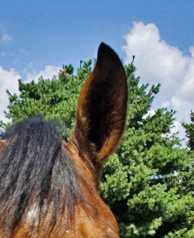|
By Jerry Tardif

|
Having a horse that dislikes having his ears touched is a problem that many people have with their horses, and one that you're smart to address.
That's because you, your barn owner (if you board), your vet, and perhaps others, will occasionally need to check your horse's ears and it's good if the horse doesn't put up a fight.
Fortunately, this is not a hard issue to address.
But it does take a little patience and it's worth your time to go through this process with your horse.
|
|
You approach this problem the same way you address any fear or dislike a horse has to an action — you desensitize them to it.
In this case, it's as easy as getting your horse used to the action and the feeling.
Start by putting your hands on his head and perhaps scratching his brow — most horses like this.
As you move your hands around his head, slide your fingers quickly up the outside of an ear and immediately off to another part of his head.
The trick is to touch the outside of his ear only, and then move your hand to touch another area before he even realizes that you did touch his ear.
You do this quickly once every time you see him and again just before you leave.
After a few days or a week of doing this, you should be able to touch the outside of his ear for a longer period of time before he complains.
Don't touch the inside of his ear during this period.
In the second week, start to touch the outside of the inside of his ear just as quickly and frequently as you did the outside of his ears the week before.
You're not just getting him used to having his ears touched, you're also building his trust in you that you won't hurt his ears.
It shouldn't be long before you can lightly scratch the inside of his ear lightly (with the bugs of summer biting, the ears may itch and this will usually feel great to a horse).
Using this approach, you should be able to work your fingers in further without your horse pulling away.
When you're doing this desensitization, it's important to touch the contested area only for very short periods of time initially, and to slowly extend the time you touch them, and then later, the depth in which you touch them.
As your horse gets used to your touching him in various spots and learns to trust you, he'll soon let you touch him almost anywhere.
And as previously mentioned, this is important for both you and your vet to be able to examine and treat bites and other wounds on his body, so it's not wasted time.
Besides being an avid trail rider, Jerry Tardif is a technology consultant and a horse and nature photographer in SE Connecticut — see his work at: www.jerrytardif.com.
He is also co-founder and President of QueryHorse.
Back to Article Index
|